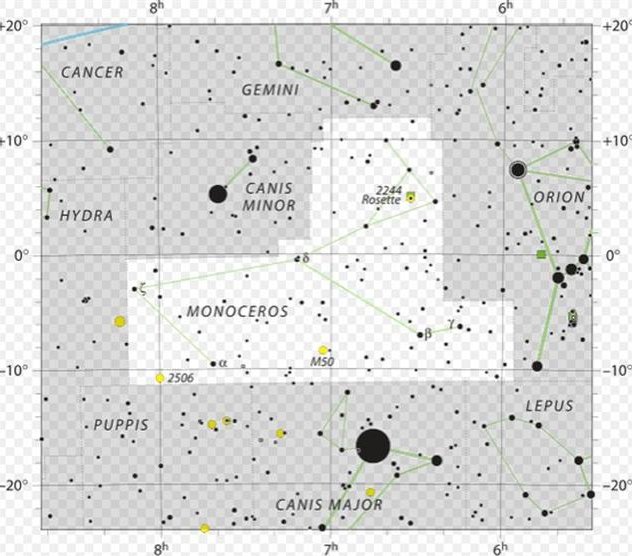Wikipedia has a star chart for Monoceros with 5 Greek lettered stars, but in my astronomy book there is also ε above β as if forming a 3rd corner in a triangle (β, δ, ε):
According to Allen none of these 6 stars have been given a proper name.
The distance from α Monocerotis to φ Sagittarii was 284.0 - 115.4 = 168.1 days (not 169 days). Or perhaps more relevant, α Monocerotis was precisely 104 (= 8 * 13) days beyond η Andromedae, which rose with the Sun in April 1 (91). 91 (η Andromedae) + 104 = 195 (July 14):
By counting from April 17 (107) at Cb1-1 to July 14 (195) we can deduce the glyph number should be 393 + (195 - 107) = 481 counted from Ca1-1. This is Cb4-18. Counting separately for the other side of the sky, where Cb1-1 probably represented October 16 (289), means finding day 289 + (195 - 107) = 377 = 365 + 12 at Cb4-18. Nash, the Arrowhead, rose heliacally in December 20 (354) and Sham, α Sagittae (the Arrow) rose 378 - 354 = 24 days later. Which was a time inside the South Dipper:
The synodic cycle of Saturn is 378 days and in rongorongo times heliacal Sham rose 378 days after the previous January 1. Before we will look at where Sham is in the text we should try with one more animal (in addition to the Unicorn). The Hare could refer to Lepus and we can count 169 (or 168) days backwards from Vrischika, which rose with the Sun in November 17 (321). 321 - 169 = 152 (June 1) = RA day 152 - 80 = 72 (= 360 / 5). This was March 13 (8 days before equinox). However, the first (ε) of my listed stars in Lepus was not rising until RA day 76.
And Arneb (α Leporis) was not rising until in RA day 83. 321 (November 17) - 80 - 83 (Arneb) = 158. Possibly the Chinese had a Hare constellation which was rising somewhat later than Lepus. The Fox could refer to Vulpecula. There is only one Greek lettered star in the constellation, viz. α at the left ear of the Fox (according to Hevelius who created it):
σ Scorpii (247.0) - 294.9 (α Vulpeculae) = - 47.9. This Fox star rose in January 10 (= 375 = 295 + 80). But there was a more famous Fox, viz. Alcor (80 Ursae Majoris). σ Scorpii (247.0) - 202.7 (Alcor) = 44.3. Then we could count 365¼ - 44.3 = 320.95 or ca 321. Possibly this number alludes to the Hare referred to as the animal of Vrischika, which star was rising with the Sun in November 17 (321). The lunar station connected with the Fox was Heart. Why was not Antares (Kalb al Akraab, the Heart of Scorpio, α) chosen instead of a nameless star? | ||||||||||||||||||||||||||||||||||||||||||||||||||||||||||||||||||||||||||||||||||||||||||||||||||||||||||||||||||||||||||||||||||||||||||||||||||||||




